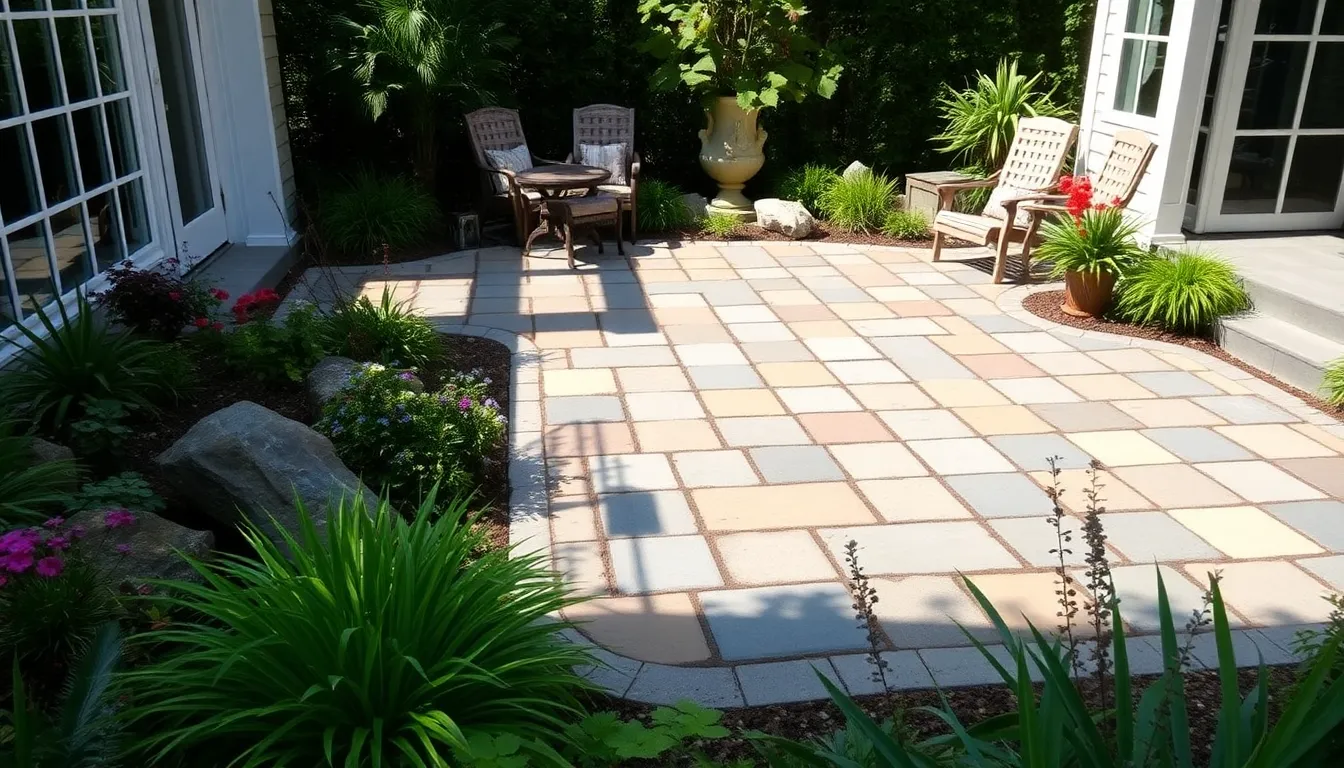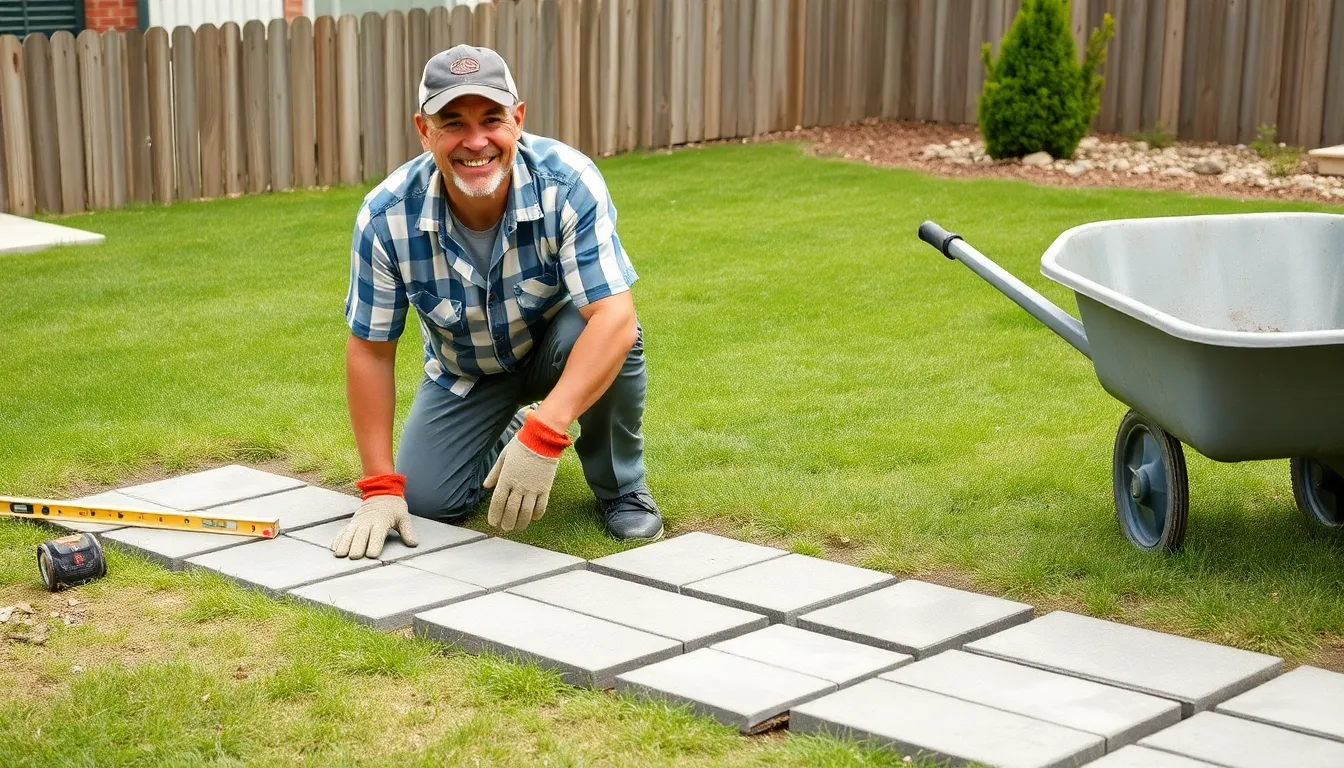Imagine transforming your backyard into the ultimate hangout spot, where barbecues sizzle and friends gather under the stars. With patio installation, that dream can become a reality. It’s not just about laying some stones; it’s about creating a space that screams relaxation and fun.
Table of Contents
ToggleOverview of Patio Installation
Patio installation involves several steps to create a functional outdoor space. First, selecting the right materials is essential, as options like concrete, brick, and pavers each offer unique aesthetics and durability. Second, homeowners must assess the chosen location, ensuring it aligns with both sunlight exposure and accessibility to the home.
Planning the layout stands as a crucial step in the installation process. Inviting elements such as seating arrangements and fire pits can enhance the area’s overall appeal. Clear measurements help define the patio size, allowing for comfortable movement and social interaction.
Excavation follows planning, where the ground is prepared for a stable foundation. Often, compacted gravel provides effective drainage and support for the structure. After leveling the base, artisans lay the selected materials, focusing on interlocking techniques for durability.
Sealing materials offers additional protection against the elements. Choices in sealants vary, providing different levels of gloss and resistance to stains. Regular maintenance extends the patio’s life and keeps it looking pristine.
Incorporating landscaping elements can enhance the overall ambiance. Plants and lighting contribute vibrant colors and create an inviting atmosphere. Successful patio installations prioritize harmony with existing outdoor features and structures.
By considering these aspects, homeowners achieve a versatile space for entertainment and relaxation. Transforming a backyard into a well-designed patio not only increases property value but also elevates outdoor living experiences significantly.
Types of Patios

Various patio types cater to different aesthetic preferences and functional needs. Each type offers distinct advantages in terms of appearance and durability.
Concrete Patios
Concrete patios present a highly versatile option for homeowners. This material can be poured in a range of designs and finishes, ensuring customization. Durability ranks high with concrete, as it withstands heavy foot traffic and diverse weather conditions. Ease of maintenance enhances its appeal because occasional cleaning suffices to maintain its appearance. Additionally, homeowners often choose stamped or stained concrete to mimic other materials while keeping costs manageable.
Paver Patios
Paver patios comprise individual stones or bricks, allowing for creative design possibilities. These units come in various colors, shapes, and sizes, enabling homeowners to create unique patterns. Installing pavers promotes efficient drainage, which reduces the likelihood of pooling water. Paver patios require minimal maintenance, and replacing a single unit is straightforward in case of damage. This adaptability makes paver patios a popular choice for those seeking both form and function in their outdoor spaces.
Stone Patios
Stone patios deliver a natural aesthetic that often enhances landscaping. Different stone types, such as flagstone or slate, bring varying textures and colors. Installing these materials provides a sturdy surface suitable for heavy furniture and gatherings. The individual stones settle into the ground, allowing for natural drainage, which minimizes erosion. Regular maintenance involves occasional cleaning and checking for shifting stones, ensuring these patios remain beautiful and functional over time.
Considerations for Patio Installation
Patio installation requires careful planning to maximize space and ensure lasting results. Choosing the right location and size plays a critical role in creating an effective outdoor area.
Location and Size
Selecting the correct location greatly influences the patio’s usability. Areas with abundant sunlight are ideal for social gatherings, while shaded spots offer comfort on hot days. Homeowners must consider proximity to the house for easy access. Additionally, the size of the patio should accommodate furniture and activities without feeling cramped. An ideal size can range from 100 to 400 square feet, depending on the intended use, like entertaining or relaxing.
Material Selection
Choosing materials impacts the appearance and durability of the patio. Concrete offers a sturdy base with customizable finishes, such as patterns and colors. Pavers provide flexibility in design with individual stones or bricks, enhancing drainage. Natural stone creates a unique aesthetic with variations in texture and color, connecting the patio to the surrounding landscape. For a cohesive look, consider how these materials interact with existing architecture and outdoor elements.
Budget Planning
Creating a budget ensures the project stays on track. Costs for patio installation can vary widely, typically ranging from $15 to $50 per square foot. Factors influencing the budget include material choice, site preparation, and labor expenses. To allocate resources effectively, homeowners should gather quotes from multiple contractors. Implementing cost-saving measures can include DIY elements or selecting less expensive materials while still achieving a desired look.
Hiring Professionals vs. DIY
Homeowners often face a choice between hiring professionals for their patio installation or taking on the project themselves. Each option presents distinct advantages and disadvantages.
Pros and Cons of Hiring Contractors
Hiring contractors offers expertise and efficiency. Professionals bring experience, ensuring proper installation and adherence to regulations. Their knowledge often leads to fewer mistakes and faster completion times. Problems may arise when costs exceed budget expectations, as labor expenses can accumulate. Communication issues can also lead to misunderstandings regarding design vision or project timeline. Ultimately, while professional assistance can streamline the process, it requires careful consideration of the budget and choice of contractors.
Benefits of DIY Patio Installation
Opting for DIY patio installation empowers homeowners to customize their outdoor space. Engaging in the project allows individuals to exercise creativity and personal preferences in design. Additionally, cost savings often occur when bypassing labor expenses. Homeowners gain valuable skills in project management and construction techniques. Challenges may surface, such as time consumption and lack of expertise, which could impact the result. Despite these hurdles, the sense of accomplishment and personal investment in the final product often outweighs the potential drawbacks.
Maintenance Tips for Your Patio
Regular cleaning prevents the buildup of dirt and debris on patio surfaces. Use a broom or leaf blower to remove loose leaves and dust. Periodically, wash the patio with a solution of water and mild soap to eliminate stains and maintain its appearance.
Inspecting for cracks or chips remains critical in preserving the integrity of the patio. Detecting small issues early allows for prompt repairs, which can prevent larger problems over time. Use a concrete patch or sealant for quick fixes on concrete surfaces.
Sealing the patio is essential, especially for porous materials like concrete and pavers. A quality sealant protects against moisture, stains, and weather damage. The application of sealant every one to three years ensures long-lasting protection.
Weeds can disrupt the aesthetic of any patio. Pulling weeds by hand or using a herbicide specifically designed for patios can effectively eliminate them. This maintenance task should occur regularly to keep the outdoor space pristine.
Consider power washing for deeper cleaning needs. This method effectively removes algae, moss, and grime from the surface. Ensure to follow proper technique to avoid damaging the surface.
Incorporate furniture protection to extend the life of patio items. Using covers during inclement weather reduces wear and tear on outdoor furniture. Storing cushions in a dry area during winter keeps them in good condition.
Lastly, regular maintenance checks help identify any drainage issues. Proper drainage prevention of standing water protects the patio’s longevity. Ensuring that any surrounding landscaping directs water away prevents erosion and prolongs the surface’s life.
Patio installation can significantly enhance outdoor living spaces. By carefully selecting materials and planning the layout, homeowners can create inviting areas for relaxation and gatherings. Whether opting for concrete, pavers, or natural stone, each choice offers unique benefits that cater to different tastes and needs.
Regular maintenance is vital to keep the patio looking its best and functioning well. With the right care, a patio can serve as a beautiful and durable extension of the home for years to come. Ultimately, investing time and effort into patio installation pays off by elevating both the aesthetic appeal and value of the property.



